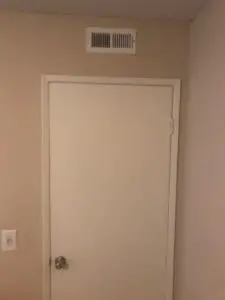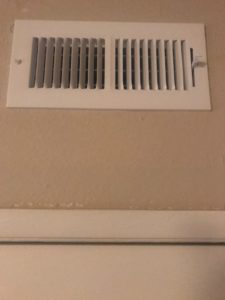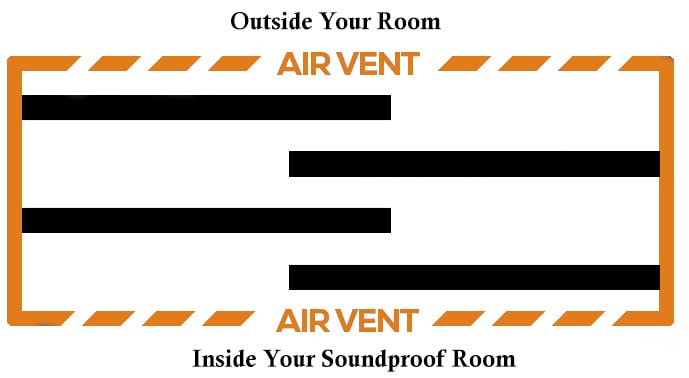How to soundproof an above-door air vent! Forgetting to soundproof your air vent will make all your other attempts at soundproofing your room useless. Don’t make this tiny mistake.
I built my home with an office that I wanted to be completely soundproof. I have a new baby, and if I’m working in my office trying to get work done, then it can be a distraction when it’s time for me to get work done.
Not to mention I also have very noisy neighbors, which also doesn’t help when I need peace and quiet.

I did a lot of work for this one special room. I put in extra insulation, two solid-wood doors, acoustic sound foam, a nice thick carpet, and some soundboard to top it off.
What I didn’t think about was the little stupid air vent above my bedroom door!
It was the perfect little tunnel to allow the enemy of sound right into my quiet soundproof room.
I knew something had to be done to eliminate this so I decided to write this article to help you guys out as well.
Noises Coming from Your Air Vent
Noises that travel through your air vents are actually called flanking noise. Flanking noise is a sound that enters your room from a path other than the wall separating a room from another room or outside.
An air vent is the perfect example of a flanking noise since it is traveling from a different path. There are many different examples where flanking noise may occur.
Here are a few examples of flanking noise:
- The sound coming through the air vents that are meant to cool the ambient room temperature (ac unit)
- Noise from inside the ductwork of the HVAC system
- The sound that may be coming from interconnected floors, ceilings, or walls within your home
- Noise from the doors and windows in your house through indirect paths
Apart from flanking noises, you may also experience other noises from your home.
This all depends on how old your system is. You may be able to hear people talking, a baby crying, television from another room, etc.
Effective Methods for Soundproofing Your Above Door Air Vent
I have found that there are really only two effective ways to soundproof the noise traveling in from the above-door air vent.
The first thing you can do is block out the vent entirely, which will then render your air vent useless. The second method to soundproofing the vent is to create a sound maze on the inside.
Creating a sound maze inside the vent will help deflect the air and noise that is traveling through.
There is a third method, but that involves a ton of work and may be very costly to somebody that is not handy around the house.
I will talk about this a little bit later. Let’s first look at a few of the easy and conventional ways to soundproof your above-door air vent.
Blocking the Air Vent Entirely


This is the most soundproof method you can do for your air vent. There are essentially two different ways you can approach this.
The first way is a lot more work and more expensive. In this approach, you can simply remove the air vent completely and then use drywall over the hole.
Doing this will, in fact, eliminate the air vent above your door completely. If you ever want the air vent back in this spot, you will need to cut out a hole and replace it with the vent.
This is actually the approach that I chose. However, I do not completely recommend it.
I thought it was a great idea at the time because I didn’t want an unusable air vent to be left above my door. It just looked a little tacky in my eyes.
The main problem is that doing it this way has completely blocked off the central air in this room. I live in California, and the Summer days can be a bit hot.
I use a few fans during the hot season to help keep the room cool. Keeping the room at operable levels hasn’t been a major problem, but I do wish some days that I had central air coming into my room instead of just using a few fans.
Nothing replaces nice cold air.
Blocking Only the Inside of the Air Vent
The other way to block the air vent is to use some sort of filler. This gap filler from amazon does a great job at insulating and sealing off the sound.
To do this, you would first simply remove the air vents. Then spray the inside area with the gap filler so that it entirely seals the area. This will effectively seal off sound or air coming through this air vent.
Put the vents back on, and you will still have a normal-looking room with air vents.
If at a later time you decide you want to have air back into your room, all you have to do is open up the vents and remove the filler that you put on earlier.
Sound Maze Method
This next method requires you to make a maze inside of the air vent called a sound maze.

This method requires more work to be done than the first method. The benefit of creating a sound maze is that you will still be able to have cold air come in through your air vent.
All while reducing the sounds coming out of your air vent. The first method completely eliminates the vent, which results in no air coming through your vent, which can cause your room to get pretty hot during the Summer season.
The sound maze method works by creating a small maze on the inside of your vent space. The maze is created in a zig-zag form using small pieces of plywood with acoustic foam taped to them.
The diagram above shows how this maze should look on the inside of the air ducts. The key is to make the sound zig-zag multiple times before it gets into your room.
Creating it in this formation will help deaden most of the sounds coming through.
Materials Needed to Create a Sound Maze in an Air Vent
- A generous amount of acoustic foam. This acoustic foam from amazon works well.
- A saw to cut the wood.
- Small screws
- glue
This method takes a little more work, but it will result in a room that is quiet but easily heated and cooled.
The way this works is that you make a miniature maze inside the vent space using pieces of thin wood with acoustic foam taped to the wood scraps.
This way, the sound has to zig-zag around several times before entering the room. This will significantly deaden most of the sounds that are coming through.
The only downside to using this method is the sound deadening isn’t as effective as completely blocking off the vent.
Although creating a sound maze will deflect a lot of the noise coming through, it won’t be able to soundproof all of it.
The air vent noises will be much more muffled as they come through the sound maze than if they didn’t travel through the maze.
In return, you get to have a working air conditioner in the room. I have not personally used or tested this design, but there are many others that have used this with good success.
Soundproofing HVAC Vents in Your Home
Another type of noise issue you may encounter can be from your HVAC system in your home. This can be another root cause of your noisy air vent.
Soundproofing your home’s HVAC system can help eliminate any noise that you may be experiencing. These systems are usually pretty complex and a lot harder to deal with.
There are a few at-home solutions you can do to help minimize these sounds coming through your air vent if you don’t prefer the other two methods from earlier.
Upgrade Your Home’s HVAC System
Usually, older HVAC systems tend to be noisier than our modern systems. We can thank this due to new technology in these more advanced HVAC systems.
Not only will a new modern system be more effective at a sound reduction, but they are also more efficient.
Having a more efficient system will save you money in the long run from your electricity bill. New HVAC systems are made with performance and efficiency in mind.
You will be surprised how much faster a room can be cooled with a system of newer technology.
If upgrading your entire system is out of your budget, then you can still benefit from changing the other less expensive parts.
Air Duct Liners
This is a cheap way to help minimize the sound coming through your air ducts. Duct liners have insulation material which helps to reduce the amount of sound that is deflected from the inside walls of the duct.
Think of the air coming through the air ducts like a ping pong ball. The air will bounce back and forth until it reaches the exit bringing all the different flanking sounds along with it.
This air duct liner from amazon is priced well and will work great.
Use Flexible Air Ducts
Flexible air ducts are very useful in negating sound coming through the air vents. Remember to only use flexible ducts when required.
The reason these work well at reducing noise is because of the bends you can make. The more bends you make in the duct means it will be more difficult for sound to travel through.
It is best to install these flexible air ducts in a zig-zag fashion for the best effect.
Seek Professional Help
If you are planning on doing some big home modifications with the size and length of your ducts, then a professional is strongly recommended.
There are a lot of pieces involved when it comes to your home’s HVAC system. Making sure it is done correctly will help warrant unneeded costs.
There are many risks involved if you plan on doing more complex work, like changing your whole HVAC system or rerouting and replacing air ducts in your home.
The cost can add up quite quickly from all the items and installation fees. It’s better to have the job done right than to have to do it all over again because you broke something or cut something too short.
Final Thoughts
If you are looking to just simply soundproof your above-door air vent in one room, then I highly recommend weighing your two options based on what best suits you.
Completely removing the air vent or covering the ducts with insulation foam is the best soundproof method.
The main downside is that the room without the air vent will not be able to be cooled by the air conditioning unit any longer.
Creating a sound maze in the air vent going to your room will help minimize the sounds coming through the vents, but not as much as completely blocking it. The plus side is that cold air will still be able to pass into your room.
If you want to help reduce the overall sound from your air ducts in your entire house, then I recommend remodeling your air ducts and changing out your HVAC system.
Although do remember that this is the most expensive choice in this scenario.
If this is within your budget, then you will most likely have to hire a professional to do this work for you unless you have some type of handyman background.




